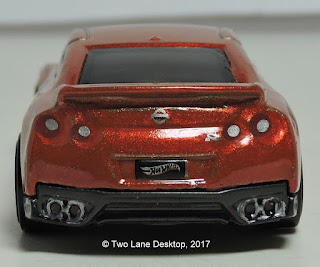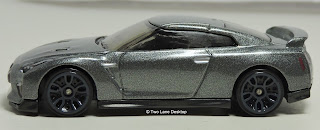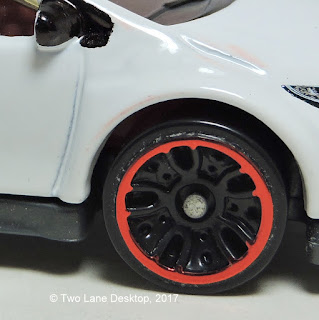Hot Wheels 2016 Honda Civic Type R and 2017 Nissan GT-R R35
2017 saw the introduction of two Japan vehicles that were highly
anticipated and a nice fit as part of the then and now lineup. While the GT-R is not part of the Then and
Now lineup for now the 2017 update is long overdue to improve the 2009 GT-R
casting and as for the Civic the Type R is a new addition to the Civic family
and flows nicely with the 1990 EF Civic in matching colors for the Then and Now
line.
2017 Nissan GT-R
For almost a decade Godzilla has been running the streets and track
terrorizing unsuspecting exotic cars that would not think much about this Japan
car being competitive against them, and throughout the years Nissan has made
minor improvements to add horsepower and then add more comfort for day-to-day
use. 2017 saw a much needed update the
GT-R to keep it fresh as Nissan decides what to do for the
next-generation. The headlights gain new
projector beam units with a crease that runs along the grille to match current
Nissan designs, a new U-shaped grille, side scoops that now conceal the running
lights, LED taillights with halo rings, larger exhaust tips, and a much-needed
interior upgrade that adds more leather in various colors, a redesign dashboard
that moves most switches and buttons to a larger touchscreen infortainment
system, and a new steering wheel. The
twin-turbo 3.8L V6 that produces 570 horsepower through a seven-speed automated
manual transmission mounted to the rear differential. While it’s performance edge is starting to
show its age it is still one wild and fast machine.
2009 saw a rather late introduction for a early-release model (it was #1 in
the New Models list but arrived in late spring of 2009) and when it did it was
pretty sleek, if a bit unfinished in a few areas. Well despite the new model it shares a lot
with the old as it has the same dimensions, lack of exterior mirrors, and
bodylines though the 2017 model has a much better look to it. The orange and gray look great on this car
and the clear headlights that are part of the windows remain though I had to
add the projector lamp setup to add differences between the two models. The front grille is now part of the metal
body is accented by a tampo graphic of the bumper and GTR badge, side scoops
are added with LED running lights, and the lower chin front spoiler is visible
and drags the bumper lower for a better look than the high-stanced front of the
2009 model. The sides also add ground
effects that are part of the base, wrap-around windshield remains, and smaller
Y-5 wheels over the 10-spokes still in gray.
The rear is much carry-over with detailed round taillights, GTR badging,
and a rear spoiler that eliminates the middle post, while the lower bumper is
lower to house the larger quad exhaust tips.
The base underneath still uses the carbon fiber pattern with only the
exhaust system visible, while the interior looks the same look again as it has
the new dashboard design with integrated infortainment screen, 3-spoke steering
wheel, center console with shifter, and supportive bucket seats; you’ll need a
larger scale model to appreciate the two-tone color design. As for performance the new one is just as
quick as the old, handles just as well, and brakes slightly better more though
much of the change was done on the exterior and interior.
2016 Honda Civic Type R and 1990 Honda Civic Si
While I’m not a big Civic fan I always like the 1999-2000 Si coupe and ever
since its introduction in 2004 the 1990 Civic EF hatchback. Well for 2017 it carries that same stock look
but now is joined by a new-generation 2016 Type R. It may seem odd that Hot Wheels would wait
until 2017 to do the 2016 when the new 2017 Type R is now available worldwide,
but either way the styling between the two are still identical. After Matchbox released the 2007 Type R
hatchback Honda has been working to erase the slow, not-so-stylish hatchback
Type R with an edgier and better-looking Type R that is more in line with past
Type R models. Japan got the new sedan
version after the Europe hatchback and it looks better with more power, so by
2016 the sedan was also sent to Europe to replace the dowdy hatchback with
sharper styling, better interior, and a surprise first: turbo power. The engine is a new 2.0L DOHC turbocharged
I-4 that produced 306 horsepower and 300 Ib-ft. of torque through a six-speed
manual transmission. This is a far cry
from the 1990 Civic Si’s naturally-aspirated 1.8L DOHC I-4 and 5-speed manual
transmission that was only sold in Japan, yet the engine would become a legend
and start the line of Type R models.
The new Civic Type R looks good in white with black trim accents and
perfectly matches the 1990 Civic EF in similar white with black trim (blue from
Kmart release was added to the 1990, though the color will likely appear on the
2016 for 2018 year). The front has an
edgier look with projector beam headlights that connect to the black grille
with red Honda logo, type R plate, and lower bumper with foglights and chin
spoiler. The side view shows a five-door
hatchback that tones down on the egg-shape look for a more sedan-like profile,
lower ground effects, and hidden rear door handles in the rear windows. At the rear is a tall rear spoiler,
taillights that connect to a rear back window like the CRX, and a lower
diffuser panel with four large exhaust tips.
The suspension reverts back to an independent rear suspension for better
handling just like the 1990 Civic in its square hatchback body that looks
typical econobox with the exception of DOHC on the front doors giving away the power
under the hood; also note that adding detailing to both models give both a
finished and complete look to appreciate the two more. The interior has seating for five with
supportive front bucket seats (some rather thick bolsters to add as I’ve sat in
a 2017 Type R at an auto show and I can see getting in and out of these seats
will be a challenge), a spacious cargo area, and a split dashboard where the
speedometer is digital at the top and the analog tachometer is at the bottom
behind the steering wheel. The smooth
shifter is still on the console and basic control layouts are still easy to
use, yet one big problem area is the rear seat: Mattel’s best way to attach the
rear rivet post is to go through the rear seats and that is not visible inside
until you look closely and see the obstruction in the rear seat. Why diecast companies tend to go this route
is beyond me, but it is an eye-sore in an otherwise fantastic casting. On the track the new Type R handles just as
fast and brisk as the 1990 Civic and like the real car will have no problem challenging
higher-priced sports cars. So with the
new Type R at Hot Wheels what will Matchbox do?
Stay tuned to find out…


































































Comments
Post a Comment